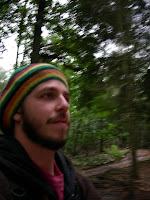 Two Loves Within/My First Storahtelling
Two Loves Within/My First Storahtelling
Oded Mazor
Storathelling at HUC Jerusalem /December 2008
I met Storahtelling the same day I met Amichai Lau-Lavie; Just over a year ago. When Amichai came to Kehilat Kol-HaNeshama in Jerusalem in December 2007, something happened in the sanctuary, and in my heart. When I was in high-school I took theater classes, but my Torah studying was done somewhere else; during my BA studies I joined a small theater group, but it was very much separated from my Jewish-Philosophy classes. Joining the Israeli rabbinic-program at the Hebrew Union College in Jerusalem I chose a different kind of stage to stand on, leading services, giving a sermon or teaching, but the acting passion was put aside. Storahtelling by Amichai at Kol-HaNeshama showed me a new path to combine these two loves of mine.
I met Storahtelling the same day I met Amichai Lau-Lavie; Just over a year ago. When Amichai came to Kehilat Kol-HaNeshama in Jerusalem in December 2007, something happened in the sanctuary, and in my heart. When I was in high-school I took theater classes, but my Torah studying was done somewhere else; during my BA studies I joined a small theater group, but it was very much separated from my Jewish-Philosophy classes. Joining the Israeli rabbinic-program at the Hebrew Union College in Jerusalem I chose a different kind of stage to stand on, leading services, giving a sermon or teaching, but the acting passion was put aside. Storahtelling by Amichai at Kol-HaNeshama showed me a new path to combine these two loves of mine.
Together, we found and built the way to have a Storahtelling-seminar in Jerusalem this year, a joint project of Storahtelling and Kol-HaNeshama, with 23 participants. I'm privileged to study with these good women and men, with Amichai as our teacher.
I'm also very privileged that Amichai supported me in doing my first Storatelling myself – just two weeks ago. It was done on a Monday morning, when I was supposed to give the Dvar-Torah during the morning prayers at the HUC. The week's Torah-portion was "Toldot", and our chosen theme was God's answer to Rivka – "Two nations are with-in you" – the notion of duality. Except for last year's Kol-Nidrei's sermon, I have never spent so much time and effort on writing a Torah related ‘presentation’ before… What ‘hat’ am I wearing here? Which of the Biblical characters will be chosen as ‘speakers’? What did he/she have to say to us today? What did our sages try to tell us through this character and her/his story?
This became a great experience for me, and I'm glad to say that the reactions of my fellow rabbinic students and faculty were inspiring. Like I felt almost a year ago, my friends and teachers at the program saw and felt the difference in approach, the strength of the method. I learned a lot about what I need to learn and practice, but that was the point for me – I wanted to try the Storahtelling Maven method by myself, to know how it felt for me and what I need to do next.
The big questions remain un-answered: what is the meaning of translating from (biblical-) Hebrew to (modern-Israeli-) Hebrew? What is the right balance between the traditional act and the renewed method? How does one prepare and present a strong and successful Storahtelling program that fits the different crowds in ones’ congregation?
But one answer I did find – there is a way to have these two nations within me live in peace, not in constant struggle in-which one of them must lose. The two forces, attractions, within me – Torah and theater – have found at least one method of working together, giving both their right place – within the synagogue, on the Bimah.
Comments: omazor@yahoo.com




No comments:
Post a Comment